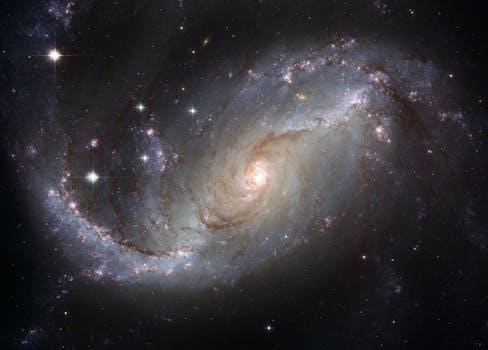gravity and orbits phet worksheet answer key pdf
Overview of Gravity and Orbits PhET Simulation
The Gravity and Orbits PhET simulation offers an interactive platform to explore gravitational forces and orbital mechanics. It allows users to manipulate celestial bodies‚ observing effects on orbital paths and gravitational interactions.

Purpose of the PhET Simulation
The PhET simulation aims to provide an engaging‚ interactive method for students to grasp complex physics concepts related to gravity and orbits. It serves as a valuable hands-on learning tool.
Interactive Exploration of Gravity and Orbits
The PhET Gravity and Orbits simulation facilitates an interactive learning experience‚ allowing students to manipulate variables such as mass‚ distance‚ and gravity. By moving celestial bodies like planets‚ suns‚ and moons‚ students can visually observe the impact on orbital paths and gravitational forces. This hands-on approach encourages students to explore the relationships between these variables and develop a deeper understanding of Kepler’s laws and Newton’s law of universal gravitation. The simulation also allows users to turn off gravity to see what would happen without it.
Hands-on Learning Tool
The PhET Gravity and Orbits simulation serves as an invaluable hands-on learning tool for students exploring gravitational concepts. Its interactive nature provides a dynamic environment where students can actively engage with the material. By manipulating variables and observing the resulting effects on orbits and gravitational forces‚ students gain a deeper‚ more intuitive grasp of these complex physics principles. This active learning approach fosters critical thinking and problem-solving skills as students analyze and interpret the simulation’s visual output. The simulation effectively bridges the gap between abstract theoretical concepts and concrete‚ observable phenomena.
Components of the PhET Simulation
The PhET simulation includes planets‚ suns‚ and moons for interactive manipulation. Users can adjust gravity force‚ velocity‚ and paths to observe orbital mechanics in action.
Planets‚ Sun‚ and Moon Interaction
The PhET simulation allows users to explore the dynamic interactions between planets‚ the sun‚ and moons‚ visualizing how each celestial body affects the others’ orbits and gravitational forces. By manipulating the mass and distance of these objects‚ students can observe real-time changes in their orbital paths. This interactive approach offers valuable insights into gravitational relationships‚ demonstrating how planets orbit stars and moons orbit planets. The simulation enables users to visualize complex gravitational interactions and develop a deeper understanding of the cosmos. The flexibility of the PhET tool makes it a valuable asset.
Gravity Force‚ Velocity and Path
The PhET simulation visually demonstrates the relationship between gravity force‚ velocity‚ and orbital paths‚ enabling students to observe the effects of these factors on celestial body movement. By adjusting parameters such as mass and distance‚ learners can witness how alterations in gravity impact the velocity and subsequent path of orbiting objects. The simulation clearly illustrates the interconnectedness of these variables. It allows users to see the effect of turning gravity off. This interactive exploration provides a deeper understanding of the physics governing planetary motion and gravitational interactions‚ showing how force‚ speed‚ and trajectory are intrinsically linked.

Worksheet Integration
Worksheets designed for the PhET simulation facilitate guided exploration and reinforce key concepts; These worksheets often include questions related to mass‚ distance‚ and orbital characteristics‚ enhancing student learning.
Lab Worksheets for Guided Exploration
Lab worksheets play a crucial role in structuring student interaction with the Gravity and Orbits PhET simulation. These worksheets provide a framework for exploring gravitational concepts. They guide students through specific tasks‚ encouraging them to manipulate variables and observe the resulting effects on orbital paths and gravitational forces. By following the instructions and prompts on the worksheets‚ students actively engage with the simulation‚ making observations‚ recording data‚ and drawing conclusions. This hands-on approach fosters a deeper understanding of the underlying physics principles. The worksheets often include a series of questions designed to test comprehension.
Questions on Mass‚ Distance‚ and Orbits
Worksheets accompanying the Gravity and Orbits PhET simulation typically include targeted questions that probe student understanding of key variables. These questions often focus on the relationships between mass‚ distance‚ and the resulting orbital characteristics. Students are asked to predict‚ observe‚ and explain how changing the mass of celestial bodies affects gravitational force. They also explore how alterations in the distance between objects influence orbital paths and speeds. Furthermore‚ questions may delve into the quantitative aspects‚ prompting students to calculate gravitational force using Newton’s Law of Universal Gravitation. By answering these questions‚ students solidify their grasp of the fundamental principles governing orbital mechanics. They also develop critical thinking and analytical skills.

Key Concepts Covered
The Gravity and Orbits PhET simulation focuses on teaching Newton’s Law of Universal Gravitation and Kepler’s Laws of Planetary Motion. It visually demonstrates the relationship between gravity‚ mass‚ distance‚ and orbital paths.
Newton’s Law of Universal Gravitation
Newton’s Law of Universal Gravitation‚ a cornerstone of classical mechanics‚ explains the attractive force between any two objects with mass. The law states that the gravitational force is directly proportional to the product of their masses and inversely proportional to the square of the distance between their centers. This means that as mass increases‚ the gravitational force also increases‚ while as distance increases‚ the gravitational force decreases significantly. The Phet simulation allows for an interactive exploration of this relationship. By manipulating mass and distance‚ students can directly observe the effects on gravitational force.
Kepler’s Laws of Planetary Motion
Kepler’s Laws of Planetary Motion describe the movement of planets around the Sun. The first law states that planets move in elliptical orbits with the Sun at one focus. The second law‚ the law of equal areas‚ says that a line joining a planet and the Sun sweeps out equal areas during equal intervals of time. The third law relates the orbital period of a planet to the size of its orbit. The Gravity and Orbits PhET simulation provides a visual and interactive way to understand these laws‚ allowing users to observe how changing parameters affects planetary motion.
Impact of Gravity on Orbits
Gravity dictates the path of orbits; without it‚ celestial bodies would drift in straight lines. The force of gravity determines orbital shape and speed‚ a key concept explored in the PhET simulation.
Effect of Turning Gravity Off
In the PhET Gravity and Orbits simulation‚ disabling gravity has a dramatic impact. With gravity absent‚ the centripetal force that maintains orbital paths vanishes. Planets‚ moons‚ and satellites no longer follow their curved trajectories. Instead‚ they move in straight lines tangential to their initial velocity vectors.
This demonstrates that gravity is essential for maintaining orbits. Without this fundamental force‚ celestial bodies would simply drift away into space. The simulation vividly illustrates Newton’s first law of motion‚ highlighting inertia’s role when no external force‚ such as gravity‚ acts upon an object.
Relationship Between Mass and Gravitational Force
The PhET Gravity and Orbits simulation effectively illustrates the direct relationship between mass and gravitational force. Increasing the mass of either celestial body – a planet or the sun – results in a stronger gravitational pull between them. This heightened force directly affects the orbital path of the less massive object‚ causing it to accelerate and potentially alter its trajectory.
Conversely‚ decreasing the mass weakens the gravitational force. This leads to a slower orbital speed and a wider orbital path. The simulation allows users to quantitatively observe how changes in mass directly impact the strength of gravitational interactions.
Answer Key and Solutions
This section offers sample answers and solutions for the Gravity and Orbits PhET simulation worksheets. It emphasizes evidence-based reasoning‚ ensuring students understand the ‘why’ behind observed phenomena.
Sample Answers and Explanations
This section provides detailed sample answers for questions posed in the Gravity and Orbits PhET simulation worksheets. These answers are designed to guide students towards a deeper understanding of the underlying physics principles. Each answer includes a thorough explanation‚ connecting observed phenomena with the relevant scientific concepts‚ such as Newton’s Law of Universal Gravitation and Kepler’s Laws of Planetary Motion. The explanations emphasize the relationship between mass‚ distance‚ gravitational force‚ and orbital paths. Furthermore‚ the provided solutions showcase how to interpret simulation results and apply them to real-world astronomical scenarios. The goal is to foster critical thinking and problem-solving skills.
Focus on Evidence-Based Reasoning
A core aspect of the answer key is its emphasis on evidence-based reasoning‚ encouraging students to support their conclusions with data and observations derived directly from the PhET simulation. Instead of simply providing answers‚ the key guides learners to analyze simulation results‚ identify patterns‚ and draw logical inferences. Students are prompted to cite specific instances within the simulation that validate their claims about gravitational forces and orbital behavior. This approach fosters a deeper understanding of the scientific method‚ as students learn to formulate hypotheses‚ test them using the simulation‚ and refine their understanding based on the evidence they gather.

Educational Value
The PhET simulation‚ combined with the worksheet and answer key‚ enhances the learning experience by fostering a deeper‚ more intuitive understanding of physics concepts related to gravity and orbital mechanics through interactive exploration.
Enhancing Understanding of Physics Concepts
The integration of the Gravity and Orbits PhET simulation and accompanying worksheet significantly enhances the understanding of complex physics concepts. By providing a visual and interactive learning environment‚ students can directly observe the effects of changing variables such as mass and distance on gravitational forces and orbital paths. This hands-on approach makes abstract ideas more concrete and accessible‚ leading to improved comprehension of Newton’s Law of Universal Gravitation and Kepler’s Laws of Planetary Motion. The answer key further supports this learning process by offering clear explanations and evidence-based reasoning‚ reinforcing key principles.
Interactive and Engaging Learning Experience
The Gravity and Orbits PhET simulation offers an interactive and engaging learning experience for students exploring physics concepts. Unlike traditional textbook learning‚ the simulation allows students to actively manipulate variables‚ such as mass and distance‚ and observe the resulting changes in gravitational forces and orbital paths in real-time. The visual representation and hands-on nature of the simulation make learning more enjoyable and memorable. The accompanying worksheet‚ with its focused questions and answer key‚ guides students through the simulation‚ encouraging them to explore‚ analyze‚ and draw conclusions based on their observations‚ promoting deeper understanding.

